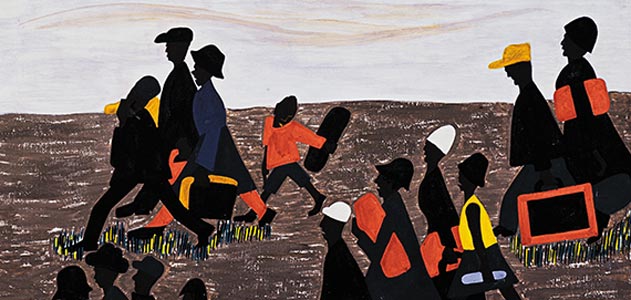Staying awake in the city that never sleeps

From Jacob Lawrence’s migration series, 1941
We used to say that New York was the city that never sleeps. More than that, it is a city that wants to keep you alert. However, the flashing signage, noise and bustling-hustling crowds in Times Square, the agitated foot and skateboard and motor traffic, the rattling subway and the hurried pace and startling changes may produce the opposite effect, stupefying you with conflicting demands on your attention and shutting down most of your brain, leaving the remaining working part so focused on whatever you’re trying to do that you mindlessly become another vector in the general agitation, avoiding obstacles but otherwise oblivious to other people and your surroundings.
All that is true, but New York also offers sites and events that invite quiet reflection, that permit you to integrate some of all those stimuli into a coherent narrative. The New York Public Library, with all its branches, has always bee such a site, and I hope it will remain so — though we heard disturbing news of plans to sell off the branches (more valuable as real estate) and ship the books out to an out-of-city warehouse. Good people are fighting to save the libraries, and good people in New York have been able to accomplish many things, so maybe it’ll all be all right.
Other great sites for reflection on where we are and what it all means include the great museums, the galleries and the theaters. We returned to Madrid yesterday after another week in New York, a city we know well — we lived there for over 30 years — and still recognize, though it is ever changing. And we took the opportunity to take in some shows at a couple of museums, several galleries and a theater: the Music Box, for the revival of Wendy Wasserstein’s 1989 hit, “The Heidi Chronicles“. Great production, terrific actors, in a very dated story that reminded us how far we have not yet come in women’s struggle for recognition and equal opportunity.
In MoMA, we spent a lot of time at the exhibit Latin America in Construction: Architecture 1955-1980 — mainly because we’ve been working on a book that includes that period. Not, in our view, a totally successful presentation of such a complicated history — as Ronald Reagan famously noted, there are a lot of different countries “down there”, and unless you already knew a lot about what you were looking at, you might not be sure whether a particular project or building was in São Paulo or Mexico, or 1952 or 1972, and some enormously important events (e.g., the coups in Chile and Argentina) were scarcely mentioned. But, if you did have some idea what you were looking at, you could find many fascinating, more obscure works that you hadn’t seen before. Susana will be writing a more detailed review, so I’ll leave my comments at that.
